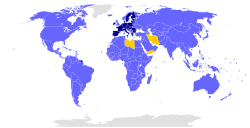
Paris Agreement
The Paris Agreement ( French : Accord de Paris ) [3] is an agreement within the United Nations Framework Convention on Climate Change (UNFCCC), dealing with greenhouse-gas-emissions mitigation , adaptation , and finance , starting in the year 2020. The agreement's language was negotiated by representatives of 196 state parties at the 21st Conference of the Parties of the UNFCCC in Le Bourget , near Paris , France , and adopted by consensus on 12 December 2015. [4] [5] As of November 2018, 195 UNFCCC members have signed the agreement, and 184 have become party to it. [1] The Paris Agreement's long-term goal is to keep the increase in global average temperature to well below 2 °C above pre-industrial levels; and to limit the increase to 1.5 °C, since this would substantially reduce the risks and effects of climate change.
Page Revisions
| Year | Metadata | Sections | Top Words | First Paragraph |
| 2018 |
201438 characters 28 sections 57 paragraphs 18 images 257 internal links 82 external links |
2. Mitigation provisions and carbon markets |
agreement 0.437 paris 0.390 parties 0.161 nationally 0.151 ndc 0.151 ndcs 0.151 adaptation 0.132 finance 0.132 sdm 0.123 member 0.121 withdrawal 0.117 2016 0.104 targets 0.104 mechanism 0.104 ambition 0.102 |
The Paris Agreement ( French : Accord de Paris ) [3] is an agreement within the United Nations Framework Convention on Climate Change (UNFCCC), dealing with greenhouse-gas-emissions mitigation , adaptation , and finance , starting in the year 2020. The agreement's language was negotiated by representatives of 196 state parties at the 21st Conference of the Parties of the UNFCCC in Le Bourget , near Paris , France , and adopted by consensus on 12 December 2015. [4] [5] As of September 2018, 195 UNFCCC members have signed the agreement, and 181 have become party to it. [1] The Paris Agreement's long-term goal is to keep the increase in global average temperature to well below 2 °C above pre-industrial levels; and to limit the increase to 1.5 °C, since this would substantially reduce the risks and effects of climate change. |
| 2017 |
198031 characters 30 sections 56 paragraphs 17 images 246 internal links 73 external links |
2. Mitigation provisions and carbon markets |
agreement 0.432 paris 0.387 parties 0.163 nationally 0.153 ndc 0.153 ndcs 0.153 adaptation 0.134 sdm 0.124 finance 0.120 withdrawal 0.119 2016 0.106 mechanism 0.105 ambition 0.104 stocktake 0.104 transparency 0.102 |
The Paris Agreement ( French : Accord de Paris ), Paris climate accord or Paris climate agreement is an agreement within the United Nations Framework Convention on Climate Change (UNFCCC) dealing with greenhouse gas emissions mitigation , adaptation and finance starting in the year 2020. The language of the agreement was negotiated by representatives of 196 parties at the 21st Conference of the Parties of the UNFCCC in Paris and adopted by consensus on 12 December 2015. [3] [4] As of November 2017, 195 UNFCCC members have signed the agreement, and 172 have become party to it. [1] The Agreement aims to respond to the global climate change threat by keeping a global temperature rise this century well below 2 degrees Celsius above pre-industrial levels and to pursue efforts to limit the temperature increase even further to 1.5 degrees Celsius. [5] |
| 2016 |
336934 characters 27 sections 50 paragraphs 212 images 440 internal links 61 external links |
2. Mitigation provisions and carbon markets |
agreement 0.396 paris 0.349 parties 0.192 nationally 0.188 ndcs 0.188 adaptation 0.155 sdm 0.153 member 0.137 2016 0.130 ambition 0.127 stocktake 0.127 ndc 0.125 mechanism 0.120 finance 0.114 framework 0.109 |
The Paris Agreement ( French : Accord de Paris ) is an agreement within the United Nations Framework Convention on Climate Change (UNFCCC) dealing with greenhouse gases emissions mitigation , adaptation and finance starting in the year 2020. The language of the agreement was negotiated by representatives of 195 countries at the 21st Conference of the Parties of the UNFCCC in Paris and adopted by consensus on 12 December 2015. [3] [4] It was opened for signature on 22 April 2016 ( Earth Day ) at a ceremony in New York. [5] As of December 2016, 194 UNFCCC members have signed the treaty, 120 of which have ratified it. After several European Union states ratified the agreement in October 2016, there were enough countries that had ratified the agreement that produce enough of the world's greenhouse gases for the agreement to enter into force. [6] The agreement went into effect on 4 November 2016. [2] |
| 2015 |
81638 characters 11 sections 14 paragraphs 10 images 218 internal links 19 external links |
nationally 0.324 agreement 0.321 ambitious 0.203 contributions 0.192 unfccc 0.170 ratify 0.152 paris 0.150 adopted 0.136 determined 0.134 ndc 0.130 member 0.127 framework 0.113 protocol 0.113 aim 0.110 set 0.106 |
The Paris Agreement ( French : L'accord de Paris ) is an agreement within the framework of the United Nations Framework Convention on Climate Change (UNFCCC) governing carbon dioxide reduction measures from 2020. The agreement was negotiated during the 21st Conference of the Parties of the UNFCCC in Paris and adopted by consensus on 12 December 2015, but has not entered into force. [1] [2] Conference head Laurent Fabius , France's foreign minister, said this "ambitious and balanced" plan was a "historic turning point" in the goal of reducing global warming . [3] |
|
| 2011 |
870 characters 0 sections 1 paragraphs 0 images 1 internal links 0 external links |
|||
| 2010 |
870 characters 0 sections 1 paragraphs 0 images 1 internal links 0 external links |